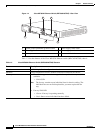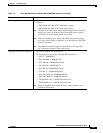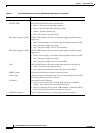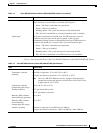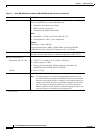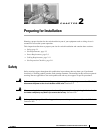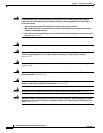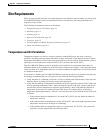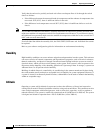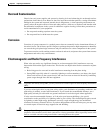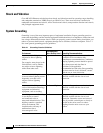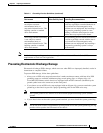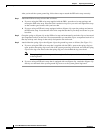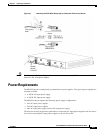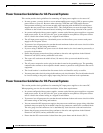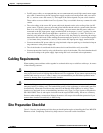
2-4
Cisco ME 6500 Series Ethernet Switch Installation Guide
OL-8900-03
Chapter 2 Preparing for Installation
Site Requirements
Verify that the enclosed or partially enclosed rack allows an adequate flow of air through the switch
chassis as follows:
• If the difference between the measured intake air temperature and the exhaust air temperature does
not exceed 50°F (10°C), there is sufficient airflow in the rack.
• If the difference in air temperature exceeds 50°F (10°C), there is insufficient airflow to cool the
chassis.
Note A Cisco ME 6524 Ethernet switch that is currently installed in an enclosed or partially enclosed rack
might meet ambient air temperature and air flow requirements now. However, if you add more chassis,
the additional heat generated might cause the ambient air temperature within the rack to exceed 104°F
(40°C) and can cause minor alarms.
If an individual fan within the assembly fails, the FAN STATUS LED turns red. Individual fans cannot
be replaced.
Refer to your software configuration guide for information on environmental monitoring.
Humidity
High-humidity conditions can cause moisture migration and penetration into the system. This moisture
can cause corrosion of internal components and degradation of properties such as electrical resistance,
thermal conductivity, and physical strength. Extreme moisture buildup inside the system can result in
electrical shorts, which can cause serious damage to the system. Each system is rated to operate at 8 to
80 percent relative humidity, with a humidity gradation of 10 percent per hour. In storage, a system can
withstand from 5 to 95 percent relative humidity.
Buildings in which climate is controlled by air-conditioning in the warmer months and by heat during
the colder months usually maintain an acceptable level of humidity for system equipment. However, if
a system is located in an unusually humid location, a dehumidifier can be used to maintain the humidity
within an acceptable range.
Altitude
Operating a system at high altitude (low pressure) reduces the efficiency of forced and convection
cooling and can result in electrical problems related to arcing and corona effects. This condition can also
cause sealed components with internal pressure, such as electrolytic capacitors, to fail or perform at
reduced efficiency. The system is certified for operation from 0 to 6500
feet (0 to 2000 m). The system
is designed and tested for operation from –200 to 10,000
feet (–60 to 3000 m).



